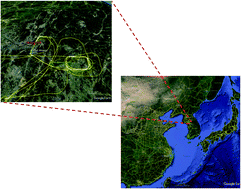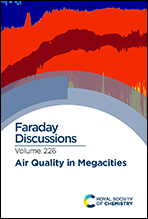The role of a suburban forest in controlling vertical trace gas and OH reactivity distributions – a case study for the Seoul metropolitan area†
Abstract
We present trace gas vertical profiles observed by instruments on the NASA DC-8 and at a ground site during the Korea-US air quality study (KORUS) field campaign in May to June 2016. We focus on the region near the Seoul metropolitan area and its surroundings where both anthropogenic and natural emission sources play an important role in local photochemistry. Integrating ground and airborne observations is the major research goal of many atmospheric chemistry field campaigns. Although airborne platforms typically aim to sample from near surface to the free troposphere, it is difficult to fly very close to the surface especially in environments with complex terrain or a populated area. A detailed analysis integrating ground and airborne observations associated with specific concentration footprints indicates that reactive trace gases are quickly oxidized below an altitude of 700 m. The total OH reactivity profile has a rapid decay in the lower part of troposphere from surface to the lowest altitude (700 m) sampled by the NASA DC-8. The decay rate is close to that of very reactive biogenic volatile organic compounds such as monoterpenes. Therefore, we argue that photochemical processes in the bottom of the boundary layer, below the typical altitude of aircraft sampling, should be thoroughly investigated to properly assess ozone and secondary aerosol formation.

- This article is part of the themed collection: Air quality in megacities


 Please wait while we load your content...
Please wait while we load your content...